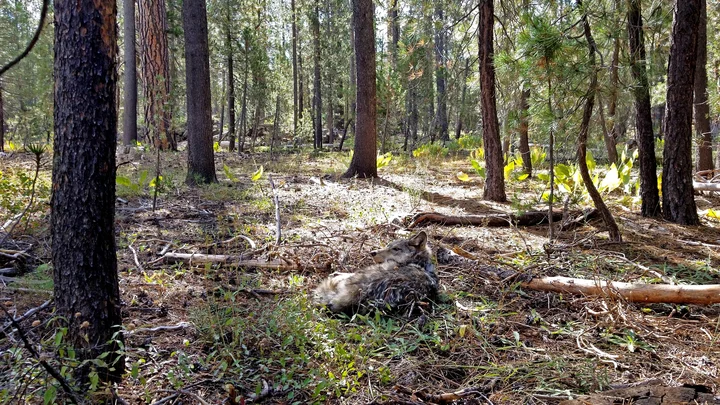Female gray wolf pup in Lassen County, September 2019. Photo by California Department of Fish and Wildlife.
###
Hooo-oowl! It’s the sound that the people of Northern California are hearing from their forests again.
The gray wolf is a species that was once native to the entire continent of North America. Its population was decimated from its conflict with human livestock and game management. While we don’t know much about the expiration of wolves in California, we can assume that it runs along the same vein as the California Grizzly. The original wolves of California were persecuted throughout the 17th and 19th centuries, when California had a mass influx of settlers looking to strike it rich during the California Gold Rush. With the influx of people, we needed more food to feed them all. As such the wolves of California were most likely killed to keep numbers of elk and deer high. Alas, because of this killing, for many years we, the State of California, did not have any wolves that called our state home until 2011.
All of our wolves here in California now originate from multiple packs that call eastern Oregon their home. The dispersal of wolves from Oregon started with OR-7, a wolf from the Imnaha pack. It was fitted with a GPS collar in early 2011 and was detected crossing into California in late 2011. OR-7 then traveled around the north-eastern counties of California until he returned to Oregon in April of 2013, where he established his own pack, the Rogue pack. After OR-7 we have had several Oregon collared wolves come to California, some of which stayed and started their own packs. The first pack that got named in California was the Shasta pack in 2015. Two wolves from the Imnaha pack in Oregon dispersed into California and started the Shasta pack. Unfortunately, we have not seen any wolves from the Shasta pack since late 2015, with the last known individual from it being genetically identified in Nevada almost a year after the last known California sighting of his pack.
Lassen Pack cubs gambol in this 2020 video clip.
The second well known pack in California is the Lassen pack. This pack has successfully sired pups from the years 2019 or 2020, to the date of writing. This pack is genetically diverse with the original male wolves being from OR-7 Rogue pack, the original female was also from Oregon. Moreover, a new adult male of unknown origin joined in 2019. He was the sire of the pups born in 2020. As of 2021, the Lassen pack is thought to consist of at least five wolves. We also have two other packs in California: Beckwourth pack of Plumas County, designated in 2021, and the Whaleback pack of east Siskiyou County, also designated in 2021.
The big question is how this may affect us here in Humboldt. The mountains here in Humboldt historically may have housed many populations of wolves. However, with the persecution for threats to humans and game, along with the historical overhunting of elk and deer, we didn’t have the necessary requirements for a suitable wolf habitat. With the reintroduction of elk, which has created a booming elk herd, we may meet the criteria for a habitat of wolves in the eastern parts of the county. We may not see them on the beaches, but with them being habitat generalists, and given the amount of open farmland and large elk populations around the Orick area, we may be able to support a small population of wolves.
Now, what does that mean for the people? Well, there can be some issues with human-wildlife conflict with the wolves, mainly in the areas of livestock. Currently, in the State of California, the gray wolf is designated an endangered species under the Endangered Species Act. (Interestingly, this designation was made at a conference here in Fortuna.) But wolves have been known to kill livestock which causes economic harm to farmers. A potential way to deal with this would be through farmer compensation, as the killing of our finite population of California wolves would be a problem for conservation.
If you have any problems or concerns with wildlife, contact the local California Department of Fish and Wildlife.
###
PREVIOUSLY:
###
Evan Vieira is a wildlife student at Cal Poly Humboldt.
Are you a high school or college student who has done research on some little-known aspect of Humboldt County’s people, places, flora, fauna? Write up a precis and share your work with the mighty Outpost audience! Email news@lostcoastoutpost.com, and put the words ‘Student Science’ in the subject line. Professors welcome too, I guess.

CLICK TO MANAGE